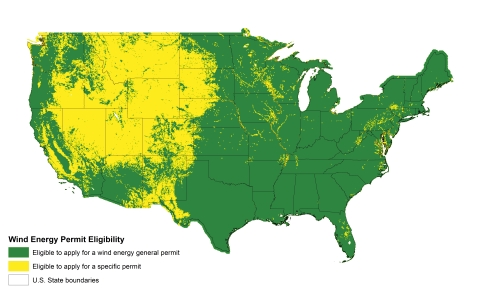Documents and Resources
The Bald and Golden Eagle Protection Act prohibits the harm and possession of bald and golden eagles and their parts, nests or eggs, except pursuant to federal regulations. The Eagle Act also authorizes the Secretary of the Interior to issue regulations to permit the taking of eagles for various purposes, provided the taking is compatible with the preservation of the bald eagle and the golden eagle.
Permits for the incidental, or unintentional, take of eagles were first established in 2009 and then revised in 2016 to authorize incidental take of bald eagles and golden eagles that results from a broad spectrum of activities, such as utility infrastructure, energy development, residential and commercial construction and resource recovery.
While significant progress was made in 2016, the Service has continued to seek ways to improve the permitting process and increase participation while maintaining the eagle preservation standard. In September 2022, the Service published a proposed rule and draft Environmental Assessment and opened a 90-day public comment period. The Service proposed to create a general permit program for certain activities, including qualifying wind energy generation projects, power line infrastructure, disturbance of bald eagles and bald eagle nest take.
The Service is now publishing a final rule that creates a new system of general permits for specific activities with the goal of increasing the conservation benefit for eagles and increasing permit compliance by the public.
Currently, the Service administers specific, or individual permits, on a case-by-case basis when permitting eagle take. An applicant prepares an application, which is submitted to the Service. Then the Service reviews the application and determines whether to issue a permit. If the Service issues a permit, it includes permit conditions specific to that project.
The Service will retain the specific-permit approach for situations that have high or uncertain risks to eagles, thus maintaining an administrative burden that is commensurate with meeting the preservation standard for eagles.
However, the Service has now created a system of general permits as an alternative approach to authorization for certain activities under prescribed conditions. The purpose of general permits is to simplify and expedite the permitting process for activities that pose relatively consistent and low risks to eagles and have well-established avoidance, minimization, and mitigation measures where take may be authorized without site-specific analysis. This approach will better direct limited Service resources toward permit applications and conservation issues that will have the largest impact on eagle conservation.
General permits have eligibility criteria to identify and authorize only those projects the Service knows to be lower risk for eagles. For example, this map (below) of the lower 48 states in the U.S. shows where wind energy projects may qualify for general permits or specific permits based on the eagle relative abundance. Please visit the ArcGIS Online site for a high-resolution view of the geographic areas and information on eagle abundance that is used to determine eligibility for general or specific permits.
In addition to general permits, the Service made improvements to the specific permit requirements and process, including the creation a tiered fee structure based on the complexity of the permit. The Service also revised permit fees and clarified definitions.
The announcement was made on February 8, 2024 and the final rule was published in the Federal Register on February 12, 2024. There is no public comment period that opens with the publication of this final rule. This rule will be effective 60 days from publication in the Federal Register, on April 12, 2024. Please visit our Eagle Management page for information on implementation of these regulations.
The notice and all related documents are available at http://www.regulations.gov, Docket Number: Docket No. FWS-HQ-MB-2020-0023.

